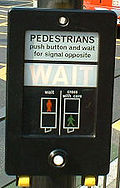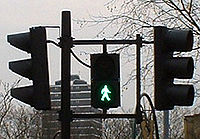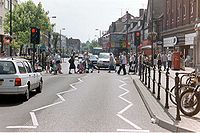
Pelican crossing
Encyclopedia



Pedestrian crossing
A pedestrian crossing or crosswalk is a designated point on a road at which some means are employed to assist pedestrians wishing to cross. They are designed to keep pedestrians together where they can be seen by motorists, and where they can cross most safely across the flow of vehicular traffic...
featuring a pair of poles each with a standard set of traffic lights facing oncoming traffic, a push button and two illuminated, coloured men facing the pedestrian from across the road - a red, stationary man to indicate that it is not safe to cross, and a green, walking man to indicate that it is safe to do so. The name is derived from PELICON, an acronym of pedestrian light controlled. The term Pelican crossing originated in the United Kingdom
United Kingdom
The United Kingdom of Great Britain and Northern IrelandIn the United Kingdom and Dependencies, other languages have been officially recognised as legitimate autochthonous languages under the European Charter for Regional or Minority Languages...
, and is not in official use elsewhere, but similar traffic control devices are in use throughout the world.
The Pelican crossing was the first definitive light controlled crossing for pedestrians in the UK, introduced in 1969, after the earlier failed experiment of the panda crossing
Panda crossing
The panda crossing was a type of signal-controlled pedestrian crossing used in the United Kingdom from 1962 to 1967.-Background:In the early 1960s, the British Ministry of Transport, headed by Ernest Marples, was looking for a way to make pedestrian crossings safer under increasingly heavy traffic...
. Previously only zebra crossing
Zebra crossing
A zebra crossing is a type of pedestrian crossing used in many places around the world. Its distinguishing feature is alternating dark and light stripes on the road surface, from which it derives its name. A zebra crossing typically gives extra rights of way to pedestrians.The use of zebra...
s had been used, which have warning signals (Belisha beacon
Belisha beacon
A Belisha beacon is an amber-coloured globe lamp atop a tall black and white pole, marking pedestrian crossings of roads in the United Kingdom, Ireland and in other countries historically influenced by Britain...
s), but no control signals. The pedestrian lights are situated on the far side of the road to the pedestrian. A puffin crossing
Puffin crossing
A pedestrian user-friendly intelligent crossing is a type of pedestrian crossing in use in the United Kingdom.It differs from a pelican crossing in that the lights controlling the pedestrians are on the near side of the road, rather than on the opposite side...
has the lights on the same side as the pedestrian; a toucan crossing
Toucan crossing
A toucan crossing is a type of pedestrian crossing found in the United Kingdom that also allows bicycles to be ridden across. Since two-can, both pedestrians and cyclists, cross together, the name toucan was chosen....
is a crossing for pedestrians and bicycle
Bicycle
A bicycle, also known as a bike, pushbike or cycle, is a human-powered, pedal-driven, single-track vehicle, having two wheels attached to a frame, one behind the other. A person who rides a bicycle is called a cyclist, or bicyclist....
s; a pegasus crossing
Pegasus crossing
A Pegasus crossing is a type of signalised pedestrian crossing with special consideration for horse riders. This type of crossing is nicknamed after the mythical winged horse, Pegasus...
allows horse-riders to cross as well. A HAWK beacon
HAWK beacon
A HAWK beacon is a traffic signal used to stop road traffic and allow pedestrians to cross safely. It is officially known as a "pedestrian hybrid beacon". The purpose of a HAWK beacon is to allow protected pedestrian crossings, stopping road traffic only as needed...
, used experimentally in the USA with a standard pedestrian crossing signal, stops traffic when a pedestrian pushes a button to cross, but goes dark unless activated.
Pelican crossings have further non-visual indication that it is safe to cross, such as a beep, vibrating button or tactile rotating cone in order to assist blind or partially sighted pedestrians.
Additionally, a Pelican crossing, as distinct from a pedestrian crossing, has the special feature that while the green man flashes to indicate that pedestrians may continue crossing but may not start to cross, the red light changes to an amber flashing light permitting cars to pass if there are no further pedestrians. This reduces the delay to traffic.
In UK law, Pelican crossings which go straight across the road are one crossing, even when there is a central island, therefore traffic must wait for pedestrians who are crossing from the other side of the island. This rule is different to similar standard pedestrian crossings where each portion of the crossing is treated as a separate crossing. However, at installations where the crossings that cross each carriageway are separate crossings, then they are staggered.
Origin
The pelican crossing was a relatively minor development of the X-way crossing. This earlier crossing was largely identical to the pelican crossing, but instead of a green light for motorists, featured a white diagonal cross. The intention of this was to distinguish the crossing lights from any nearby junction (standard) traffic lights). The white cross was widely critisised and users and motoring organisations alike called for the white cross to be replaced by a green light. With some changes to the light timings and road markings, the X-way crossing became the pelican crossing.External links
- BBC article, on the introduction of Panda crossings, and subsequent developments.

